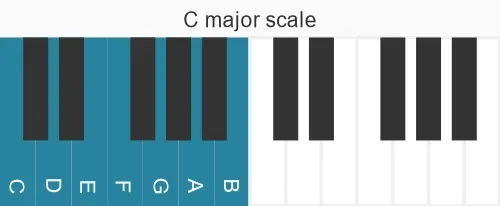The dominant chord, oh my: where to start!? It might be the most used chord in the world. It encapsulates an entire musical style (the blues). Has any jazz-solist mezmerized over the endless possibilities of scales you can play on it. And keeps classical musicians awake at night thinking how to use it next. It literally opens up new worlds in any direction.
The 7 chord has a twang. A drive. A tension. It wants to be used over and over again. Being resolved and come back in many ways. The biggest reason this tension exists is because it has a diminished fifth. The most unstable interval to exist in western 12 tone music. It is an interval that is exactly half of the octave. Making it super dissonant and powerful.
In major, the seventh chord is mainly used on the fifth degree, which resolves back to the first. To explain this further, check out C major and it's fifth degree G7.
C D E F G A B -- the notes in a C major scale
Creating a seventh chord from the tonic on the first degree would make a Cmaj7 chord: C E G B. A major triad with a major seventh on top.
Doing the same from G would create G7: G B D F. A major triad with a minor seventh on top.

Now the most important part: the G7 chord has an F and a B, both of which are one semitone next to a chord-note of C (the notes C and E)! Together with that twangy sound of the diminished fifth in a 7 chord this creates the perfect match for writing awesome compositions.
Play it and you can feel the conviction of the dominant chord!
Usage and play
Because it is so widely accepted, and you can do so much with it, you will find this chord in any musical style. From pop to rock, samba to flamenco, classical to metal. Some ways of using it are:
Play it instead of a diatonic chord degree. For instance: Playing in C would give you G7 on the fifth degree. But playing in F major you'd have C7. To go from C to F you could play C7 in between, while still playing in C major. Doing that, it would seem for a bit that you are playing in F, but after going back from F to C (maybe using G7 in between) your tonic will still be C and you will have created an interesting chord scheme. The C major scale does not have a Bb, but a B. Though for a second you can play and will love the Bb!
The same can be done in minor, for example: Am has Em on the fifth degree. But you will certainly hear E7 just as much being used. Again, the G# in E7 is so strong that you can swap it for the diatonic chord degree. You can do this almost to any degree in major and minor!
Blues
Blues music has a particular special connection with the seventh chord. The typical 12 bar blues, only uses 7th chords!!! And any other blues related style, although maybe not only, use them more often than other chords. This exceeds "normal" theoretical music and is hard to explain why it works. But it does prove the strength of the chord.
Jazz
In Jazz this chord is used as a starting point to do all kinds of things. Interchanging the tonic with a tritone. Swapping it for an otherwise diatonic chord degree. Or adding notes to make it even more twangy (and at times insane). Many of which chords and their respective scales you can find on this website.
